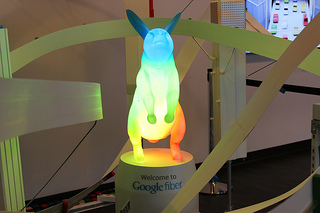Google has done a good job of avoiding the discussion of the effects of the equipment in their and other networks have on quality of experience. They discuss what happens outside their network and imply that buffering problems are caused by the content providers, other service providers, and inadequate peering arrangements. I agree that all of those components are potential culprits for the dreaded “buffering” message, but Google neglects to mention that network equipment, in and out of the Google network, contain buffers.
Those buffers fill and empty as packets transit through them. When they are flooded with video traffic they fill to capacity and other traffic has to wait until the queue is not full anymore before it can start accepting packets again. It is this effect that “slows” down packets on the network the most. Network operators can either make the queues very large or they can choose to set up multiple queues to manage packets based on parameters such as traffic type. This is where the issue of packet prioritization comes in.
Google is implying that since most of the problems with buffering happen outside their network, content caching in their network will solve the problem for Google Fiber. It will certainly help but there are still multiple network elements between the caching servers and the customer that have queues that can become bogged down. Proper traffic management will reduce the latency and jitter of those time-sensitive services to ensure a quality experience for all traffic types. I truly wish that the people at Google Fiber would have discussed this aspect as well, but it would fly in the face of the other part of Google that is against paid peering and prioritization.
By Todd R. Weiss | Posted 2014-05-27
Google says it is working more closely with content providers to make service as efficient as possible, including allowing content providers to install their networking gear in Google facilities.
Google Fiber wants users to know that it is continuously working hard to ensure that its customers are getting the best service possible, making constant adjustments and configuring to keep bothersome video buffering to a minimum.
Jeffrey Burgan, Google Fiber’s director of network engineering,dove into the issue of buffering and how Google is working to fight it in a May 21 post on theGoogle Fiber Blog.
“We’ve all had the moment where we scratch our heads and ask, ‘why is this video so slow?'” wrote Burgan. “Unfortunately, there’s no single answer to this question. Your video ‘packets’ of online bits and bytes have to travel a really long way, along several different networks, just to get to you, and they could be slowed down anywhere. So, because we know you want to stream videos and browse effortlessly, we’ve designed our network to minimize buffering.”
But the Google network is only one part of the service delivery chain, wrote Burgan. “We also partner with content providers (like YouTube, Netflix, and Akamai) to make the rest of your video’s journey shorter and faster. (This doesn’t involve any deals to prioritize their video ‘packets’ over others or otherwise discriminate among Internet traffic—we don’t do that.)”
Network bottlenecks that can slow users’ connections can also be found in other parts of the system, including in places such as the connections between Google’s network and the systems of content providers, wrote Burgan. If those connections are slow, it will affect content delivery to end users, no matter how fast their own Internet connections are, he explained.








